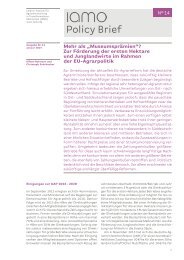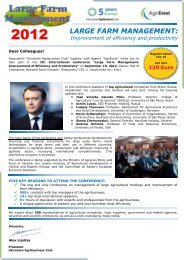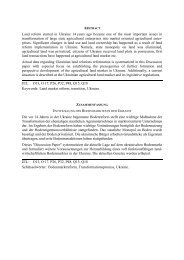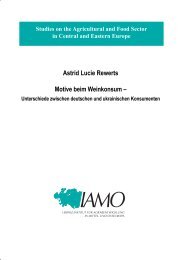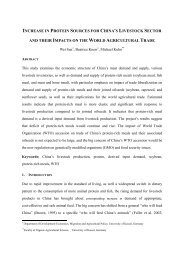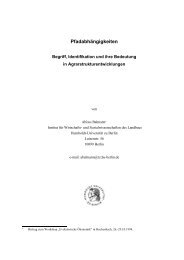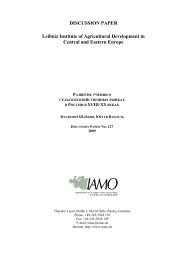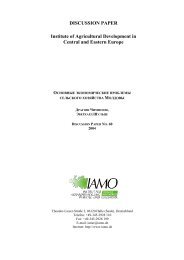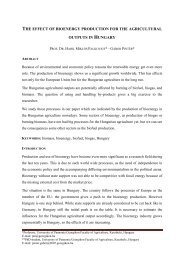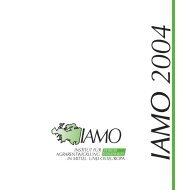Abstract - IAMO
Abstract - IAMO
Abstract - IAMO
Create successful ePaper yourself
Turn your PDF publications into a flip-book with our unique Google optimized e-Paper software.
8 ANDREAS WILDERMUTH<br />
The paper is organised as follows. Section 2 provides a brief overview of the development of<br />
Soviet and Russian all-risk crop insurance under the socialist system and in the first years of<br />
the transformation period, investigating the causes of the decline of crop insurance in Russia.<br />
Section 3 analyses the legal framework of the reorganisation of crop insurance started in 1997.<br />
Section 4 compares this conservative approach, which retains all-risk crop insurance and tries<br />
to remedy the deficiencies in its design, to the Czech approach to crop insurance reform, the<br />
transition from a compulsory state-subsidised multiple-peril crop insurance scheme to<br />
specific-risk crop insurance organised along strictly commercial lines. This strictly<br />
commercial approach could be - mutatis mutandis - an alternative way of reforming Russian<br />
crop insurance. Section 5 discusses the pros and cons of multiple-peril and all-risk crop<br />
insurance from an allocative point of view, concluding that there is no allocative justification<br />
for this type of crop insurance. This implies that crop insurance should be of the specific-risk<br />
type, i.e. it should offer cover for only a limited number of carefully selected risks. To obtain<br />
further results, section 6 develops a simple theoretical framework for analysing two issues:<br />
first, which perils should be included; second, whether and, if yes, how the government should<br />
intervene. Based on the results of section 5, section 7 discusses issues in the design of<br />
specific-risk crop insurance. Section 8 concludes the paper, summing up the policy<br />
implications for crop insurance reform in Russia.<br />
2 THE DECLINE OF RUSSIAN CROP INSURANCE AND ITS CAUSES<br />
Up to 1990 the Soviet Union had a state-subsidised compulsory all-risk crop insurance<br />
scheme for agricultural enterprises (kolkhozes and sovkhozes), which was run by the state<br />
insurance company Gosstrakh. This all-risk scheme insured all crops (except hay) against all<br />
possible natural hazards. If, due to a natural hazard, an agricultural enterprise’s yield of a<br />
certain crop fell below the threshold of 70% of the average of the preceding five years, an<br />
indemnity was paid that covered 100% of the loss beyond the threshold. The indemnity<br />
payment was computed by multiplying the yield shortfall with state procurement prices. The<br />
premium was calculated by multiplying average gross revenue (average yield times state<br />
procurement price) with premium rates set by the state. The system of premium rate<br />
differentiation to account for varying risk in different agroclimatic regions was very crude.<br />
Premium rates were differentiated only according to relatively large territorial units (oblasts,<br />
krais and republics) (ZADKOV 1997, pp. 45, 47).<br />
The state monopoly on insurance as well as compulsory crop insurance expired on 31st<br />
December 1990. But contrary to other branches of insurance that were left to the market, crop<br />
insurance has continued to be run by the Russian government, which has retained the authority<br />
to determine the perils to be covered, the premium rates, and the other relevant terms of<br />
insurance contracts. The policy chosen by the Russian governments since then has been to<br />
retain a state-subsidised all-risk crop insurance scheme. The only major change is that<br />
nowadays it is voluntary. Until mid-1997, when the Russian government embarked on a<br />
reorganisation of crop insurance, the state covered the administrative cost of the scheme, and<br />
paid a premium subsidy of 25%, though actual subsidisation was lower due to the fact that<br />
insurance premiums had to be paid out of post-tax profits. The sale of crop insurance contracts<br />
as well as their servicing (loss adjustment, monitoring of farming practices etc.) has been<br />
sourced out to private insurance companies hired by the federal government for that purpose<br />
(ZADKOV 1997, pp. 45-46, 48, 51; KIKHTEV and NAGORNOV 1997, p. 65; SCHWARZ 1999a).



